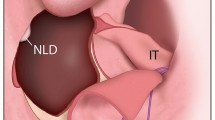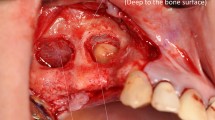Abstract
Mesiodens, which emerge towards the nasal cavity, often require consultation in maxillofacial practice. Typically accessed through wide palatal flaps with ostectomy, this method involves limited visibility and poses the risk of damaging the roots and apex of adjacent dental structures. This study advocates a minimally invasive technique that involves vestibulotomy between the central incisors, facilitating direct and rapid access through nasal floor dissection, minimizing comorbidities. A systematic review was performed, following the PRISMA guidelines, apropos on ten clinical cases reported in this study. The MEDLINE/Pubmed and Web of Science databases were searched. Several variables were considered and are presented comprehensively in tables and figures. Additionally, 10 case reports with mesiodens in the maxilla were submitted to surgical treatment using a minimally invasive intraoral transnasal disinclusion. The initial literature search resulted in 37 articles, of which 9 met the inclusion criteria for the analysis. Regarding postoperative complications, no bone exposure, incisor root damage, extensive surgical approach, palatal or vestibular hematoma, or palatal necrosis was observed. However, 10% experienced superficial damage to the nasopalatine neurovascular, while 80% and 20% presented mild and moderate postoperative facial edema, respectively. Hypoesthesia in 20% of patients recovered in the first week, 40% in the first month and 40% at 3 months. The minimally invasive intraoral, transnasal, non-endoscopic approach emerges as a safe and predictable alternative to conventional surgical techniques. Presumes minimal postoperative complications, mitigating the risk of excessive bone removal and damage to adjacent structures.


Similar content being viewed by others
Data availability
No datasets were generated or analysed during the current study.
References
Anthonappa RP, King NM, Rabie ABM (2013) Aetiology of supernumerary teeth: a literature review. Eur Arch Paediatr Dent 14(5):279–288
Wang XP, Fan J (2011) Molecular genetics of supernumerary tooth formation. Genesis 49(4):261–277
Lu X, Yu F, Liu J, Cai W, Zhao Y, Zhao S et al (2017) The epidemiology of supernumerary teeth and the associated molecular mechanism. Organogenesis 13(3):71–82
McBeain M, Miloro M (2018) Characteristics of supernumerary teeth in nonsyndromic population in an urban dental school setting. J Oral Maxillofac Surg 76(5):933–938
Garvey MT, Barry HJ, Blake M (1999) Supernumerary teeth–an overview of classification, diagnosis and management. J Can Dent Assoc 65(11):612–616
Ata-Ali F, Ata-Ali J, Peñarrocha-Oltra D, Peñarrocha-Diago M (2014) Prevalence, etiology, diagnosis, treatment and complications of supernumerary teeth. J Clin Exp Dent 6(4):e414–e418
Juuri E, Balic A (2017) The biology underlying abnormalities of tooth number in humans. J Dent Res 96(11):1248–1256
Kong J, Peng Z, Zhong T, Shu H, Wang J, Kuang Y et al (2022) Clinical analysis of approach selection of extraction of maxillary embedded mesiodens in children. Dis Markers 2022:6517024
Hauer L, Hrusak D, Jambura J, Gencur J, Hosticka L, Andrle P et al (2019) Modified maxillary vestibular approach with subperiostal intranasal dissection for surgical extractions of mesiodentes impacted in the floor of the nasal cavity. J Craniomaxillofac Surg 47(1):1–5
Sharifi R, Shafiei S, Moslemi H, Mohammadi Khah M (2021) Intraoral transnasal approach for surgical extraction of bilateral deeply impacted mesiodens: a case report. Clin Case Rep 9(11):e05037
Machol K, Mendoza-Londono R, Lee B (2006) Cleidocranial dysplasia spectrum disorder. In: Adam MP, Feldman J, Mirzaa GM, Pagon RA, Wallace SE, Bean LJH et al (eds) GeneReviews®. University of Washington, Seattle, Seattle (WA)
Sammartino G, Trosino O, Perillo L, Cioffi A, Marenzi G, Mortellaro C (2011) Alternative transoral approach for intranasal tooth extraction. J Craniofac Surg 22(5):1944–1946
Sukegawa S, Kanno T, Kawakami K, Shibata A, Takahashi Y, Furuki Y (2015) Use of a piezosurgery technique to remove a deeply impacted supernumerary tooth in the anterior maxilla. Case Rep Dent 2015:974169
Costa SM, de Jesus AO, Silveira RL, Amaral MBF (2019) Supernumerary nasal tooth removed with a modified maxillary vestibular approach: case report and literature review. Oral Maxillofac Surg 23(2):247–252
Figueroa L, Smith R, Daza J, Polanco A, Andraca F (2022) Transoral approach for intranasal supernumerary tooth extraction. Case report and literature review. Int J Odontostomat 16(2):222–226
Elseyoufi M, Hasan Alrabiaa A, Tsakiris P (2023) Removal of nasally impacted mesiodens by maxillary vestibular transnasal approach. Adv Oral Maxillofacial Surg 10:100420
Ku JK, Jeon WY, Baek JA (2023) Case series and technical report of nasal floor approach for mesiodens. J Korean Assoc Oral Maxillofac Surg 49(4):214–7
Yamamoto A, Hanazawa Y (2019) An effective mesiodens extraction method involving an intraoral approach through the nasal floor bone. Oral Sci Int 16(3):193–195
Ahmed N, Halim MS, Khalid S, Ghani ZA, Jamayet NB (2022) Evaluation of golden percentage in natural maxillary anterior teeth width: a systematic review. J Prosthet Dent 127(6):845e1–845e9
Primosch RE (1981) Anterior supernumerary teeth–assessment and surgical intervention in children. Pediatr Dent 3(2):204–215
Funding
The authors declare that no funds, grants, or other support were received during the preparation, development and publication of this manuscript.
Author information
Authors and Affiliations
Contributions
All authors contributed to the conception and design of the study. S.D., F.J. and G.M. prepared the material, collected and analyzed the data. The disagreements were resolved by consensus and discussion with a fourth reviewer, P.T., who acted as judge to resolve the disagreements generated. All authors read and approved the final manuscript.
Corresponding author
Ethics declarations
Competing interests
The authors declare no competing interests.
Ethics approval
This study was performed in line with the principles of the Declaration of Helsinki, the identity of the patients remained anonymous according to the ethical principles. For this study, all signed informed consents were obtained from the patients; that said, approval by an ethics committee was not justified or required.
Consent to participate
The use of the clinical cases with their respective images is supported by the informed consent obtained and signed by all legally responsible adults of the individual participants included in this study.
Consent to publish
The authors affirm that the legal guardians of the human research participants gave their informed consent for the publication of the images in Fig. 1a, b, c, d, e and f.
Additional information
Publisher’s Note
Springer Nature remains neutral with regard to jurisdictional claims in published maps and institutional affiliations.
Rights and permissions
Springer Nature or its licensor (e.g. a society or other partner) holds exclusive rights to this article under a publishing agreement with the author(s) or other rightsholder(s); author self-archiving of the accepted manuscript version of this article is solely governed by the terms of such publishing agreement and applicable law.
About this article
Cite this article
Tapia Contreras, P., Jollán Peña, F., Díaz Abarza, S. et al. Minimally invasive intraoral removal of mesiodens via a transnasal, non-endoscopic approach: a systematic review on the purpose of 10 cases. Oral Maxillofac Surg (2024). https://doi.org/10.1007/s10006-024-01242-1
Received:
Accepted:
Published:
DOI: https://doi.org/10.1007/s10006-024-01242-1




